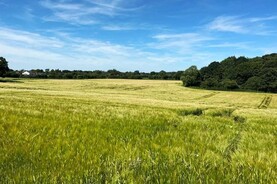Tullamore Farm drafted the first of its 2024 lamb crop on Thursday, 20 June, with a batch of 16 lambs slaughtered in Irish Country Meats Camolin, through the Offaly Quality Lamb Producer Group. The 16 lambs recorded an average carcase payment weight of 21.17kg and at an average price of €8.63/kg, they generated an average sales value of €182.59 per head.
The March-born lambs killed positively, achieving an average kill-out of 48.1%. There was significant variation, however, between kill-out, resulting in the main from breed, gender and ewe parity influences. There was a 50:50 split between lambs reared as singles and twins. Lambs reared as singles killed marginally better than lambs reared as twins. This was expected, with single-born lambs generally growing significantly faster, but differences between lambs in 2024 has overall been small.
Farm manager Shaun Diver explains that the lower-than-expected difference in liveweight gain between single- and- twin-reared lambs has been influenced by single-reared lambs being faced with a more challenging grazing environment, with twin-suckling ewes and their lambs given priority access to the best-quality grass in early lactation.
Breed differences
While numbers slaughtered are small, there were some clear differences evident. Male lambs born to mule ewes and exhibiting more crossbred genetics recorded a lower kill-out, with such lambs killing in the region of 44% to 47%. Shaun explains that there was another cohort of similar-weight male lambs, weighing from 42kg to 45kg, but these were held back until the next draft.
All lambs recorded a fat score of 3.0 and hence fat cover was not a big factor influencing kill-out. As expected, U-grading lambs, younger lambs and those exhibiting more continental genetics achieved a kill-out of 48% to 50%, on average, with a 42kg ewe lamb from a continental-cross ewe reflecting this statement and killing at 50%.
Reports from producer groups and some farmers paint a similar picture of significant variance in slaughter performance. This should be borne in mind when drafting lambs at present.
Lamb performance
Lamb performance appears to be holding relatively well despite lower-than-normal grass growth rates and sward quality being harder to maintain. Mixed grazing is helping in this regard, with two batches of twin-suckling ewes being run with suckler cows and their calves. Ewes and lambs are being afforded an opportunity to graze ahead of, or with cows and calves, and this is working well, with cows cleaning out swards without hampering performance.
The aim at present is to wean lambs in about two weeks. At this stage lambs and cows/calves will receive priority grass, with ewes used to clean out paddocks. As will be discussed in greater detail below, if grass growth rates dip again over the coming week, then a decision may be taken to wean lambs to reduce demand and ensure sufficient volumes of grass are available.
Grass growth
Last week’s growth rate increased somewhat on previous weeks at 56kg DM/ha, but is still running below the norm for the time of year. Demand is running at 33kg DM/ha at present, but this presents a false impression of grass supplies. The farm’s average farm cover is just 443kg DM/ha, with demand and growth rates closely aligned for much of May and early June.
A bag of 29-0-14 (protected urea) was blanket-spread across grazing ground ahead of last week’s rainfall, which Shaun reports has helped to sustain growth on paddocks with a cover of grass. Grass growth recovery has been much slower on grazed paddocks, while Shaun comments that growth on first-cut silage swards has been particularly poor, with fields barely greening up after over three weeks of regrowth.
With grass heading out faster, a decision was also taken to cut 12 acres on Friday, which was targeted for hay. Growth had slowed significantly and delaying cutting any further would only have resulted in lower-quality feed, rather than delivering any significant extra bulk. Grass was shook out twice and baled as good-quality haylage on Tuesday. It is hoped that getting this ground back in to the rotation earlier will help lift the average farm cover and present opportunities to develop a grass surplus and bolster winter feed supplies.
Growth consequences
Shaun is hoping that growth in the short term will remain at a level that will avoid having to wean lambs early or take additional steps, such as introducing silage to cows to slow up the rotation. A quick analysis of grass growth rates through the month of May by Shaun shows the average grass growth rate running 30kg DM/ha per day lower.
This translates to over 50t DM across the farm, or if viewed on a round bale basis, it is the equivalent of missing out of upwards 200 round bales of silage, which could have been saved from the farm as surplus grass or utilised by grazing livestock to boost performance.
Shaun estimates that the yield of first-cut silage was 15% to 20% below normal. The shortfall in the first cut will be compensated for by a significant volume of silage carried over from 2023.
Feed supplies should be sufficient, provided growth picks up quickly on second-cut swards.
Open day
The 2024 Suckler and Sheep Open Day, supported by Zurich Farm Insurance, and held on Tullamore Farm on Tuesday, 23 July, from 10.30am to 5pm, is approaching fast. A farm walk will deliver an in-depth view into the farm’s physical and financial performance, the beef and sheep systems, grassland management and also feature technical stands, workshops, demos and a host of trade stands. It is a day not to be missed for suckler and sheep farmers.






 This is a subscriber-only article
This is a subscriber-only article










SHARING OPTIONS: